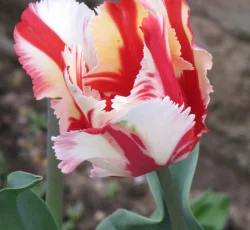
Duc van Tol Rose Tulip
Tulipa 'Duc van Tol Rose
Duc van Tol Rose is a petite tulip with pointed pink and white petals.
EXPLORE THIS PLANT
Duc van Tol Rose is a petite tulip with pointed pink and white petals.
EXPLORE THIS PLANT
Early Louisiana is a petite yellow daffodil that is well suited to naturalizing. It does well towards the front of the flower border.
EXPLORE THIS PLANT
This small, spreading native tree offers a profusion of purplish-pink flowers lining the dark branches in April, followed by large heart-shaped leaves. The redbud evolved in the understory and wood edges of forests, where it is sheltered from intense sunlight, and is prettiest planted among dogwoods and other small spring- flowering shrubs.
EXPLORE THIS PLANT
Eglantine roses are large and sprawling, with single pale pink flowers in late spring and early summer. They are strongly apple-scented and their hips are popular for use in tea. This rose may be restrained by growing on posts or trellises to control its long, thorny canes.
EXPLORE THIS PLANT
Egyptian walking onions are a unique plant which produces the next generation in a crown of bulblets atop their stalks in lieu of flowers. As the bulblets grow, their weight pulls them to the ground, where they take root to grow new plants. While the young bulbs are mild and can be used as scallions, old bulbs are quite pungent.
EXPLORE THIS PLANT
Endive has broad, bright green leaves and looks somewhat like a rougher-textured lettuce. It has a sharp, bitter flavor.
EXPLORE THIS PLANT
Cascading blue flowers on arching stems slowly naturalize in the garden.
EXPLORE THIS PLANT
With its cute white flower, this petite daisy makes a charming addition to the garden. It is usually grown as a short-lived perennial, but it will reseed if permitted.
EXPLORE THIS PLANT
Fava beans, a cool season plant, performs best in either the spring or the fall. They are quite robust and can grow to three feet high, producing many large pods which are best eaten shelled.
EXPLORE THIS PLANT
Flaming Parrot is a favorite here at Mount Vernon, with its bold red stripes on fringed yellow petals. It is a tall, late-blooming tulip that does well in the middle of the border.
EXPLORE THIS PLANT